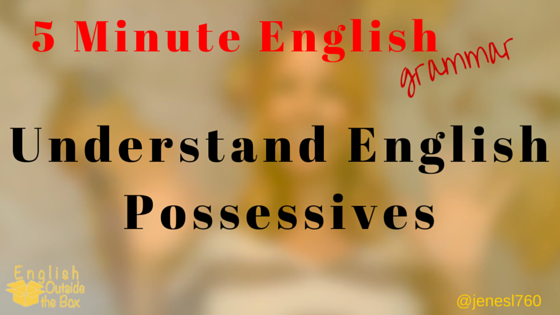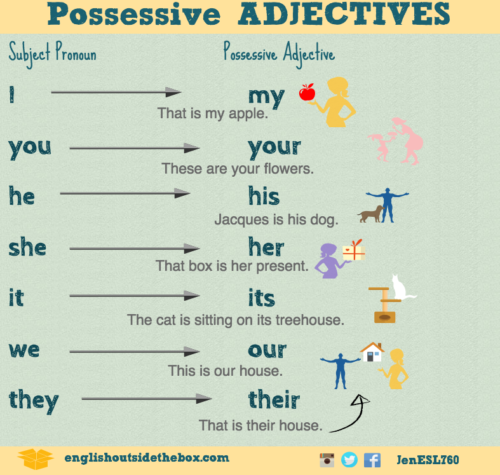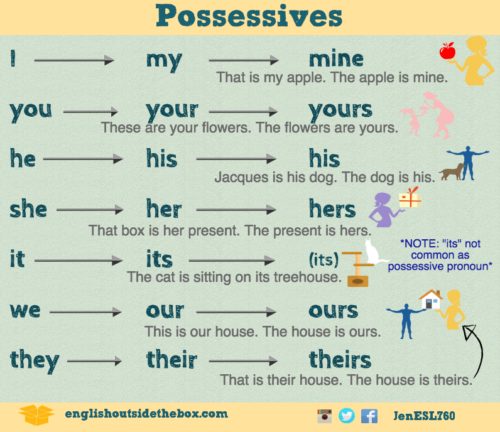
Understand English Possessives
As I think about the topics to write on my blog for you, I often consider what your biggest difficulties may be. Yours may differ from another English learner, and another reader’s weakness may differ from yours. This week I realized how confusing POSSESSIVES could be in English, and I thought do my readers really understand English possessives? Is this grammar topic their biggest weakness? Is it yours? I think the answer is definitely, “YES, it’s a weakness.” So today I will help everyone eliminate this grammar doubt.
Before today’s 5 Minute English lesson and video, let’s quickly review the introduction that I just wrote for you so you can begin to understand possessives and the different types of English pronouns that were used.
“I” was used several times and this is a subject pronoun. This is not a possessive, but we’ll talk about the possessives that relate to this subject pronoun later. The other subject pronouns are: you, it, he, she, they, we
“my” was the next word in red, and this IS an example of a possessive. More specifically, this is a possessive adjective. I also used the possessive adjectives “your” and “their” in my introduction. The other possessive adjectives we will review today are: its, his, her, our
“you” was used in my introduction and may be confusing because this word can be a subject pronoun or an object pronoun. This is not a possessive, but important in English grammar. In the example above this is an object pronoun, it follows a verb and preposition. We won’t review object pronouns today, but just for your knowledge the others are: me, it, him, her, them, us
“Yours” is a word you see in red above 3 times. “Yours” is an example of a possessive pronoun. We will definitely review these in today’s 5 Minute English lesson, but just for a quick review, the others are: mine, its his, hers, theirs, ours
“reader’s” is the last example of a possessive you see in my introduction, and is an example of a possessive noun. As you will learn, possessive nouns include a noun/pronoun + ‘s (or s’).
So what will you learn in today’s English lesson? Today you will learn and understand the following English possessives:
- possessive nouns
- possessive adjectives
- possessive pronouns
Are you ready to do this? First watch this video, then read below for more examples, and finally the end of this post will include practice questions.
Possessive Nouns
Possessive nouns are regular or proper nouns that have an apostrophe ( ‘) and “s” on the end of it; for example: friend’s, teacher’s (regular nouns) or Jen’s, Paulo’s (proper nouns). To show possession, these noun +’s must come BEFORE the object that is owned/in possession.
The example in the video was:
This is Jen’s office.
Plural nouns will differ because we do not add an ‘s. Because the noun already ends in an “s”, we just an apostrophe to the end. This also needs to come before the noun that is owned/in possession.
The example you heard was:
This is my parents’ house.
*NOTE: many languages will translate to show possession as, “This is the office of Jen” or “This is the house of my parents”; however, do not use this structure because it sounds unnatural. Native English speakers do not commonly use this structure.
Some additional examples are:
SINGULAR NOUNS
I borrowed my friend’s computer.
We stayed at my aunt’s vacation rental.
PLURAL NOUNS
You never go to your cousins’ parties.
He ate all of his co-workers’ food.
Possessive Adjectives
As you heard in the video, possessive adjectives are the following words:
my your its your his her our their
The most important rule for you to remember is that these possessive adjectives are always followed by a noun. So, you must memorize the pattern, possessive adjective + noun
To review the examples from the video:
This is my office.
That is his car.
That is their house.
Additionally you saw this infographic:

Use this to review more examples and the correct structure.
Another important rule to remember for possessive adjectives is that “ITS” never has an apostrophe! Never (never, never) use an apostrophe + s (‘s) with the word “it” when talking about possessives. The word “it’s” is the contraction of “it is” and again, does not show possession.
Possessive Pronouns
Finally, we reviewed possessive pronouns. As you heard in the video section of this lesson, these words are:
mine yours its his hers ours theirs
These pronouns replace a noun in a sentence to avoid repetition, so use them in the same places that you use nouns. They go at the beginning, as the subject, or at the end as an object.
The examples you heard were:
That scarf is mine. (mine = object)
Mine is over there. (mine = subject)
Review additional sentence examples in this infographic:
You can see that “its” as a possessive pronoun is not common, so there is not an example provided.
Are you ready to practice?
English Possessive Practice
Remember it’s important to practice what you learn, so here is your practice for today’s lesson. You can comment your answers below this blog post, under the YouTube video, on social media (@ jenESL760) or we can review it together in online Skype lessons. Learn more about Skype lessons here.
Practice Questions/Prompts:
- Tell me about your biggest weakness in English. (be sure to use the possessive adjective “my”)
- Does your family have any pets? Tell me about these pets (include the pet’s name, type/breed, their favorite toys/activities, etc..)
- Choose 3 people and tell me about their favorite things (be sure to use possessive nouns, ex: my friend Ashlee’s favorite food is….)
Complete the sentences with the correct possessive pronoun.
- That is not John’s hat, _____ is on the table.
- We cannot drive Mark’s car, because it is not even _____.
- If you don’t go to Taylor’s house, you can come to ______. Our house is much bigger!
- I don’t think Oliver and Isabella brought their dogs. _______ are too wild.
I hope you learned a lot in this post today, and I hope that you sign up to receive even more English tips and resources. You can have these lessons (and more) sent directly to your inbox. How cool is that?! You can sign up for that below this post.
If you know anyone learning English, please send them this lesson to help them understand English possessives, too.
As always…


please I want to understand when to use the apostrophe. Is it only for possessive noun only or the other two
Thanks, Jenny.
Thanks for this detailed explanation on possessive nouns. Awesome!
1. Tell me about your biggest weakness in English. (be sure to use the possessive adjective “my”)
I think my biggest weakness in English is my accent. I think people can understand me but they immediately realise I’m foreign.
2. Does your family have any pets? Tell me about these pets (include the pet’s name, type/breed, their favorite toys/activities, etc..)
My family have a cat, his name is Benji. He’s really cute and adorable but quite grumpy as well.
3. Choose 3 people and tell me about their favorite things (be sure to use possessive nouns, ex: my friend Ashlee’s favorite food is….)
My flatmate’s favourite food is curry, she loves animals and her favourite animal is lemur.
My Dad’s favourite food is Spanish omelette, his favourite subject at school was Maths and he loves teaching Maths now.
My friend Marta’s favourite restaurant is McDonalds, her favourite food is chicken burger and chips.
Complete the sentences with the correct possessive pronoun.
That is not John’s hat, his is on the table.
We cannot drive Mark’s car, because it is not even ours.
If you don’t go to Taylor’s house, you can come to ours. Our house is much bigger!
I don’t think Oliver and Isabella brought their dogs. They are too wild
-My family has* (in American English)…
-favorite animal is a* lemur.
-food is a* Spanish omelette.
-food is a* chicken…
-Theirs* are too wild
Great job!!!
[…] the verb “want”). The second example of produce is a noun (it’s followed by the possessive adjective “my”). So, following the rule above, we know that the first word is pronounced proDUCE […]